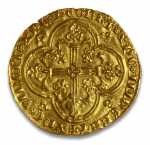1360
Birth of the franc
After being captured by the English in 1356, France’s King John II (also known as John the Good) was released in 1360 but ordered to pay the remainder of his ransom. He passed three tax and monetary laws, including one creating a new gold currency, known as the franc à cheval (the horseback franc). The new franc was to become the only currency in use throughout the realm, and its stability was guaranteed by the monarch. John II promised to end the currency manipulations that had marked the reigns of his predecessors. The name « franc », which means freed in English, was adopted in reference to John the Good’s liberation. To help raise funds for his ransom, the king also introduced a new tax, known as an aide, which was kept in place by his son and successor, Charles V. Charles also minted new franc coins showing the king standing upright rather than on horseback – these became known as the franc à pied (franc on foot) in contrast with their predecessor, the franc à cheval.


